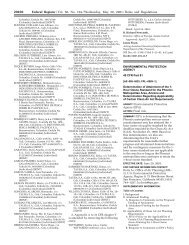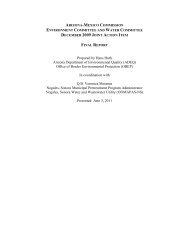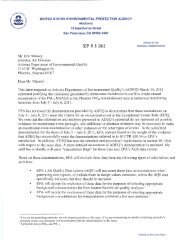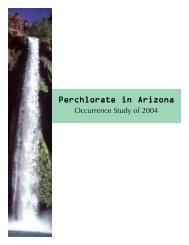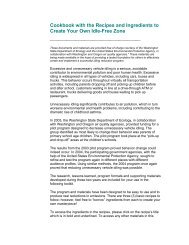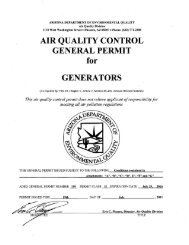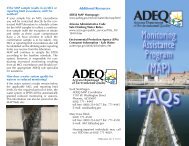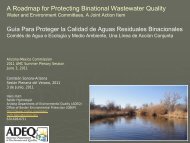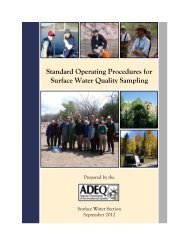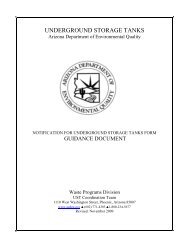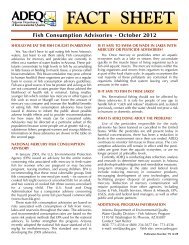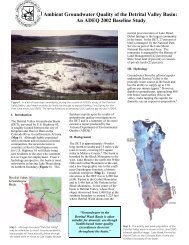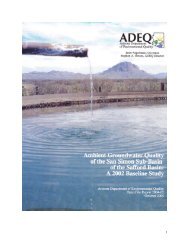Method 549.1- Diquat & Paraquot
Method 549.1- Diquat & Paraquot
Method 549.1- Diquat & Paraquot
- No tags were found...
Create successful ePaper yourself
Turn your PDF publications into a flip-book with our unique Google optimized e-Paper software.
Originator:Kenyon C. Carlson, ManagerADEQ QA UnitContact ForInformation: Kenyon C. Carlson, ManagerADEQ QA UnitI. SCOPE AND APPLICATION:METHOD <strong>549.1</strong>This is a high performance liquid chromatography (HPLC) analytical method for thedetermination of diquat (1,1'-ethylene-2,2'-bipyridilium dibromide salt) and paraquat (1,1'-dimethyl-4,4'-bipyridilium dichloride salt) in drinking water sources and finished drinkingwater. When this method is used to analyze unfamiliar samples, compound identificationshould be supported by at least one additional qualitative technique. The use of a photodiodearray detector provides ultraviolet spectra that can be used for the qualitative confirmation.The following compounds can be determined using this method:Chemical Abstract ServicesAnalyteRegistry Numbers (CASRN)<strong>Diquat</strong> 85-00-7Paraquat 1910-42-5II.REAGENTS:‣ Sodium Thiosulfate (Na 2 S 2 O 3 ) solutionIII.MATERIALS:‣ Polyvinyl chloride (PVC) or amber glass, 1-liter, sample bottle fitted with screwcaps.‣ Latex gloves‣ Folding card table‣ Protective eyewear‣ Plastic container for disposal of used pipette tips‣ Disposable glass pipette and rubber bulb.‣ Pool and Spa 3-Way Test Strips (Chem Lab Products, Inc.)‣ Paper towels & Kim Wipes‣ Pliers1
IV.PROCEDURE:1. Remove any attachments such as hoses, screens or aeration devices on the faucet.Inspect the faucet for anything that may fall into the sample container.2. Open the tap and allow the system to flush for about 10 minutes. This should besufficiently long enough to allow the water temperature to stabilize and get arepresentative sample.3. Adjust the water flow to about 1000 ml/minute or slow enough that no air bubblespurge the sample when collecting from the flowing stream.4. Remove the cap from the sampling container. Do not rinse the container as it hasalready been acid rinsed and might already contain sodium thiosulfate as apreservative.5. To fill, tip the bottle to about a 45° angle into the stream of water. Ensure the streamis sufficiently slow so as to be able to anticipate when the bottle is nearly full and thusavoid over flowing. Fill the bottle to within approximately ½ inch of the mouth.6. Remove the bottle from the flow and recap. Invert the sample bottle five times.7. Place a chlorine detector strip on a dry opened paper towel. Remove the screw-oncap and obtain an aliquot of the sample using a glass pipette. Moisten the chlorinedetector strip with the aliquot from the glass pipette and immediately flick thechlorine detector strip once using a sharp wrist motion to shake off the excess water.Compare the strip with the reference chlorine range. A determination must be madewithin 30 seconds.8. If no chlorine is detected, recap the bottle firmly, dry the sample bottle, attach thesample/laboratory label to the bottle and secure the chain of custody seal around thecap. Record the results in the field notebook and place the sample bottle in the icechest to cool to 4°C. until the sample is extracted.9. If chlorine is present, add 5 drops of sodium thiosulfate solution, recap the bottlefirmly and invert 5 times. Place a chlorine detector strip on a dry opened paper towel.10. Remove the screw-on cap and obtain an aliquot of the sample using a glass pipette.Thoroughly moisten the chlorine detector strip with the aliquot from the glass pipetteand immediately flick the chlorine detector strip once using a sharp wrist motion toshake off the excess water. Compare the strip with the reference chlorine range. Adetermination must be made within 30 seconds.2
IV.PROCEDURE (continued):11. If no chlorine is detected, recap the bottle firmly, dry the sample bottle, attach thesample/laboratory label to the bottle and secure the chain of custody seal around thecap. Record the results in the field notebook and place the sample bottle in the icechest to cool to 4°C until the sample is extracted.12. Continue the process of adding sodium thiosulfate to the sample, recapping, mixing,and testing until no chlorine is detected. Remember to note the number of drops ofsodium thiosulfate added to the water sample in the field notebook.V. SAMPLE TRANSPORT:After obtaining the water samples, attach the completed chain of custody seal around theplastic cap of each sampling bottle. The samples must be iced or refrigerated at 4°C from thetime of collection until extraction and analysis. If amber bottles are not available, protect thesamples from the light. Always use chopped, grated, or dry ice when chilling the samples fortransportation. Never use “blue ice” as the samples will not adequately chill. Field samplesthat will not be received at the laboratory on the day of collection must be packaged forshipment with sufficient ice to ensure they will be at 4°C upon arrival at the laboratory.VI.SAMPLE PRESERVATION:Analyte stability over time depends upon the matrix tested. All samples must be extractedwithin 7 days of collection. Extracts must be analyzed within 21 days of extraction. Protectthe sample from sunlight to prevent chemical deterioration of the analytes. <strong>Diquat</strong> isparticularly sensitive to sunlight. Samples which are biologically active (e.g. surface waters),must be preserved by adding sulfuric acid to reduce the pH to < 2. Acidification of thesample to a low pH prevents adsorption of the method analytes by the humectant material.VII.DEFINITIONS:A. Sodium Thiosulfate (Na 2 S 2 O 3 ): A preservative use to dechlorinate water samples.Reduces free chlorine into acid.B. Eluant: The solvent that contains the analytes after extraction or desorption.3
VIII. SAFETY:The use of protective eyewear and laboratory quality latex gloves is highly recommendedwhen collecting and preserving samples.IX.SUMMARY OF METHOD:METHOD <strong>549.1</strong>: A measured volume of liquid sample, approximately 250 ml, is adjusted toa pH of 10.5. The sample is extracted using a C8 solid sorbent cartridge or a C-8 disk that hasbeen specifically prepared for the reversed-phase, ion pair mode. The disk or cartridge iseluted using 4.5 ml of an acidic aqueous solvent. After the ion pair is added to the eluate, thefinal volume is adjusted to 5.0 ml. Liquid chromatographic conditions are selected whichpermit the separation and measurement of diquat and paraquat in the extract by absorbancedetection at 308 nm and 257 nm. A photodiode array detector is utilized to providesimultaneous detection and confirmation of the method analytes. Analysis of diquat andparaquat is complicated by their ionic nature. Glassware should be deactivated to prevent lossof analytes. The substitution of polyvinylchloride (PVC) for glass is recommended.4



